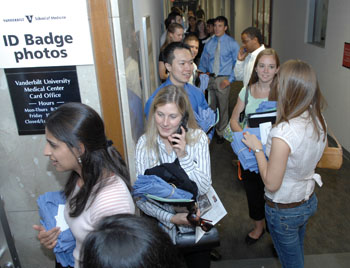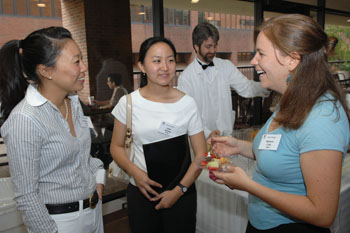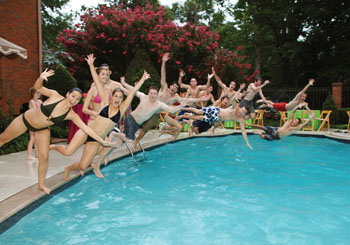
Incoming School of Medicine students wait to get identification badges during their first week at Vanderbilt. (photo by Neil Brake)
New curriculum, enhanced facilities await incoming Medical School class

From left, incoming VUSM students Christina Ahn, Julia Kutaka and Rebecca Cook. (photo by Neil Brake)

VUSM Dean Steven Gabbe, M.D., at orientation. (photo by Neil Brake)

The VUSM class of 2011 is ready to dive into its medical education. (photo by Neil Brake)
Monday was the first day of class for 104 first-year Vanderbilt University School of Medicine students.
They took the initial steps on a four-year journey unlike that of their predecessors, because they will experience a number of changes and enhancements to the medical school program that take effect this academic year. VUSM Dean Steven Gabbe, M.D., welcomed the students at orientation and outlined some of these changes.
“We have a very simple mission: to train the best students, educated by the best faculty, in the best environment, to become the best physicians and scientists,” he told the excited and enthusiastic group of students gathered in Light Hall.
In support of that mission, this class will be the first to benefit from the new integrated curriculum throughout its four years of training and the first class to use more than $10 million in new educational facilities — including the Center for Experiential Learning and Assessment, with its state-of-the-art Standardized Patient Center and Simulation Center, as well as the new anatomy laboratory on the top floor of the Vanderbilt Institute for Imaging Science.
This year’s class is more than prepared to take on the role of pioneers. As Harry Jacobson, M.D., vice chancellor for Health Affairs, pointed out during orientation, they are an exceptional group, which boasts an average MCAT score of 11.5 and a collective 3.8 GPA.
“I know this is going to be one of the most memorable mornings of your life,” he said. “Congratulations on the dedication and sacrifice it took to make it here today. It's my pleasure to welcome you to Vanderbilt School of Medicine. It is one of the finest medical schools in the country, and it's made better by the class that enters today.”
Associate Dean of Admissions John Zic, M.D., introduced the classmates to each other.
The 104 incoming first-year medical students span 30 states including Tennessee (20), Florida (10), Georgia (4), California (10), New York (5), and nine are citizens from other countries, including Canada, Ethiopia, India, Republic of Korea, Poland, Taiwan and Thailand.
“Moving here from Toronto, I would say that people are just so much warmer and friendlier here,” said first-year student Christina Ahn, who comes to Vanderbilt from Harvard. “This is my first experience with the American South and I have to say it's just been a pleasure. The staff is so enthusiastic to welcome us and you can really feel the closeness and sense of community and that people really care and invest in students.”
Together they represent 51 different colleges and universities, with 16 completing their undergraduate work at Vanderbilt and 19 representing Ivy League schools, including seven from Harvard University.
“It's been nice to have a day to meet people. It's thrilling to be here and to realize how interesting our classmates are,” said Rebecca Cook, who is originally from Kenya and comes to Vanderbilt from Wake Forest University, where she majored in biology.
Upon completion of the “Foundations of the Profession” course, first-year students will receive their white coats in a ceremony on Friday, Aug. 17, on the lawn of the Chapman Quadrangle.
VUSM's new and improved offerings
New curriculum
The class of 2011 can take pride in knowing they are experiencing the first expansive changes to Vanderbilt's medical education in 40 years.
“It's not that we haven't done a good job — we are consistently training wonderful people and wonderful graduates,” said Bonnie Miller, M.D., associate dean for Undergraduate Medical Education. “But there is always room for improvement. To be an outstanding physician in the 21st century, it is going to take a different skill set than we have taught in the past.”
Curriculum changes include:
• A two-week "Foundations of the Profession" course, which will prepare students for their entry into the medical profession
• Blocks of courses that have been integrated across disciplines and intersessions that will explore a topic that has been presented in the previous block
• A 17-week "Structure, Function and Development" course, which integrates anatomy, physiology, histology and embryology into a more systems-based approach.
• The new "Patient, Profession & Society" course for both first- and second-year students that covers topics, such as health care financing, not typically included in classic pre-clinical education
• An interdisciplinary four-year curriculum that will help students appreciate the personal and societal burden of chronic illness. Sixteen Family Nurse Practitioner students will also participate in this program.
• A six-week block of Microbiology and Immunology that completes the first-year curriculum.
CELA
They will also be among the first students to use the Center for Experiential Learning and Assessment (CELA), a new center to enhance the training of medical and nursing students, residents, faculty and staff so that patient care is optimized. CELA is located in Medical Research Building IV above Langford Auditorium. It is home to both a new standardized patient program and a technical-based Center for Medical Simulation.
• CELA is an 11,000-square-foot, $6 million facility where students learn in an innovative environment that utilizes simulations.
• The center's standardized patients can be trained to portray patients, family members and health care professionals. In addition, they are able to provide valuable feedback to learners.
• The center also wields a range of simulation technologies, including computerized mannequins that are able to reproduce a wide variety of routine and critical clinical situations. One floor of the two-story facility will include 12 clinic exam rooms, and the other will include a flexible space that triples as a six-bed ED, a four-bed ICU, or a couple of operating rooms — all monitored by microphones and cameras.
Anatomy lab
Anatomy instruction, conducted in the same lab space on the first floor of Medical Center North since 1925, has moved to a new $6.4 million facility on the 10th floor of VIIS, high atop the new multi-story addition to MCN.
• At 7,300 square feet, the new lab will be twice the size of the former one.
• Movable partitions will lend added flexibility. Along with 27 dissection tables, there will be two demonstration tables, each equipped with cameras and full surgical lighting, and each surrounded by viewing platforms. There will also be ample changing rooms for students.
• Compared to seven air exchanges per hour in the current lab, the air circulation in the new lab will provide 22 exchanges per hour, making it virtually odor free.













